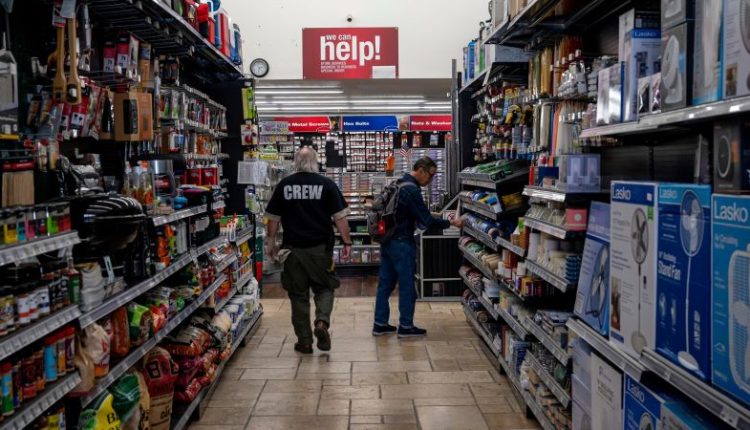Yet another favorable piece of economic data shows that price hikes are slowing and that long-unruly inflation appears to be tamed.
The Personal Consumption Expenditures price index — a closely watched inflation gauge that the Federal Reserve uses for its 2% target — slowed to 2.5% for the 12 months ended in June from 2.6% the month before, according to Commerce Department data released Friday.
Economists had projected the annual increase would slow to 2.5%, according to FactSet consensus estimates.
Wall Street responded favorably to the report, with the Dow surging by close to 700 points, or 1.7%. The S&P 500 and the Nasdaq Composite gained about 1%.
On a monthly basis, the price index increased by 0.1%, also landing in line with expectations.
Friday’s data was the clincher on what was an overwhelmingly solid second quarter for the US economy and the lengthy battle to lower inflation. During the past three months, price hikes slowed — quashing fears that the first-quarter inflation flare-up was a reacceleration — while the economy grew and labor market remained on solid footing.
“Now that we have the second quarter’s data, it really was a perfect offset for that frustrating start of the year,” Matt Colyar, a Moody’s Analytics economist, told CNN in an interview. “[The first-quarter inflation acceleration] … had a lot of measurement weirdness, and those things bore out in the second quarter, which was great. And I think that’s why the Fed now is focusing on how to best set the table for rate cuts.”
The Fed appears to be on course to nail the elusive “soft landing” of reining in high inflation without dragging the economy into a recession.
The Fed meets next week for its July policymaking meeting, and markets overwhelmingly expect the central bank to hold rates steady and start cutting in September, according to the CME FedWatch Tool.
Falling energy prices, which dropped 2.1% from May, continued to help put a damper on overall inflation in June, as did goods prices, which dropped 0.2%. Food and services inflation increased just 0.1% and 0.2%, respectively, for the month.
Excluding food and energy, categories that are often quite volatile, the core PCE index rose 0.2% for the month and held at an annual rate of 2.6% — remaining at a three-year low.
The Commerce Department’s monthly Personal Income and Outlays report also includes critical data on how Americans earn, spend and save.
And, based on Friday’s data, those household finances are still holding up fairly well on average.
Spending increased 0.3% from May, as Americans continued to put most of their money toward services and experiences, including housing and international travel, according to the report. Taking inflation out of the equation, real spending was still up for the month, rising 0.2%.
“Households did not retrench but they reduced their spending on autos, restaurants and hotels while spending cautiously on furniture, clothing, recreational services and transportation services,” Gregory Daco, EY’s chief economist, wrote in a note issued Friday.
Had it not been for the ransomware attack that crippled a critical car dealership software program, personal spending would have been even higher in June, wrote Kathy Bostjancic, chief economist at Nationwide, in a Friday note to clients.
“As such, the momentum for consumer spending as we entered [the third quarter] is strong and will support overall activity on the quarter,” she wrote.
Still, the sheer amount of spending activity will likely be more muted, with employment growth slowing and savings shrinking, she said. In June, the personal saving rate dipped to 3.4%, its lowest level since December 2022, according to the latest Commerce Department data.
The stage appears to be set for the Fed to roll out a quarter-point cut in September and December — and also even possibly in November, Moody’s Colyar said.
But for those to occur, inflation and jobs data need to remain on their current trajectory, and it’s the latter that holds the greater risk, he added.
“If there is something that would knock us off course, I think it has to come in the labor market,” he said. “In this post-pandemic, restrictive policy [environment], there’s a real pessimism, like an anxiety that a downturn is around the corner.”
“So I’ve never underestimated the potential of a bad jobs report,” he added. “There’s a brittleness in our psychology, and I think that is the kind of thing that could make things worse more quickly.”
Monthly employment gains remain historically strong but have cooled significantly from the gangbusters job growth seen during the past three years. In June, the US economy added 206,000 jobs, a slight downswing from 215,000 the month before; but the unemployment rate rose for the third month in a row to 4.1%, its highest since November 2021.
Next week, a slew of labor market data will be released — including the seminal monthly jobs report on Friday — and will provide a crucial look at the health of the US’ employment activity.
Economists are expecting July’s job gains to tally 180,000 and for the unemployment rate to stay at 4.1%, according to FactSet estimates.
“The things that we’ve reliably fed into our estimate [of 175,000 net jobs added in July] still aren’t flashing red,” Colyar said, noting slightly rising (but not alarmingly so) unemployment claims. “To this point, the labor market has not shown any significant signs of a rapid slowdown, it’s been more of a gradual cooling.”
Read the full article here

